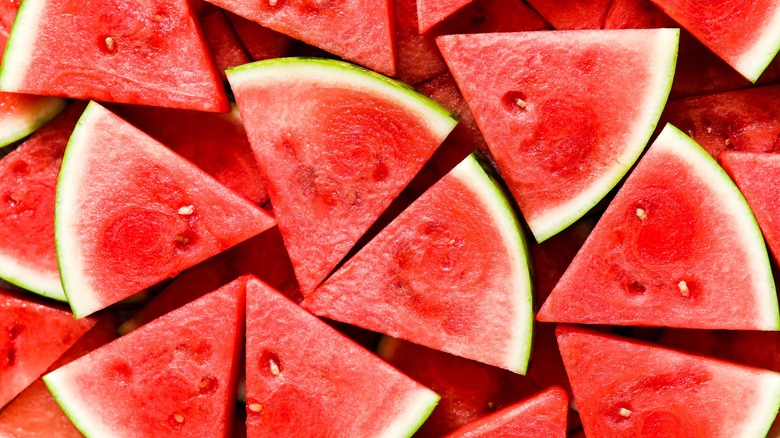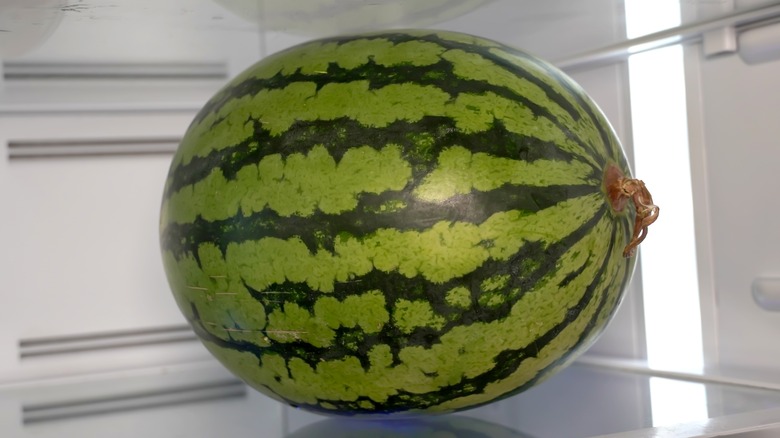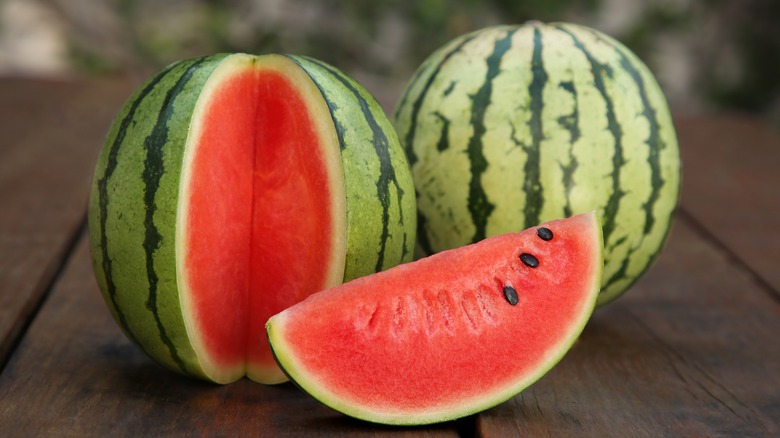The Only Reason You Should Actually Refrigerate Watermelon
You've agonized over the big display of beautiful, striated, or dark green watermelons, picking them up, weighing them in your hands, and giving them a gentle thump to see how they sound. Now that you've finally chosen the most perfect watermelon ever, do you know the best way to store that gorgeous fruit? It's a well-known fact that watermelon is at its most delicious and refreshing when it's nice and cold. However, that doesn't mean you should slide that whole watermelon into the fridge — at least, not yet.
To keep watermelon tasting its best with peak quantities of nutrients, you should actually store whole melons at room temperature for one to two weeks. That thick, solid rind will protect the flesh inside without the need for refrigeration. Keep watermelons on the counter in your kitchen or on a cool porch, and away from direct sunlight.
These storage guidelines are specific for whole melons that are ripe but not overripe, though. So, if you've passed that two-week mark or you've already cut your melon into pieces, it's time to put your melon into the fridge. Most importantly, once your melon has been refrigerated, keep it that way. Even if you put it into the fridge too early, you shouldn't take it out again and store it on the counter.
Overripe watermelons need to chill
The only time you should refrigerate a whole watermelon is when it has been sitting around a little too long, and is beginning to get overripe. On the outside of the melon look for these signs: dark splotches, shriveling, soft spots, or the stripes on the skin look less distinct than before. The watermelon may also be more fragrant. You can also try knocking on the melon with your knuckles; an overripe watermelon will have a dull thud instead of a hollow sound. If your whole watermelon has any of these signs, place it in the fridge — the cold will help preserve the fruit for another day or two at which point it should be sliced up and eaten.
Make sure the watermelon you choose at the store is at the perfect stage of ripeness so you'll have some wiggle room before it needs to be sliced. A ripe watermelon should be heavy, firm, and sound hollow when you gently thump it with your knuckles. The skin will be somewhat dull (shiny watermelons are likely underripe.) Also, the spot on the watermelon, which is where it rested on the ground while growing, should be yellow to orange in color.
If it's sliced, watermelon definitely needs the fridge
Since the thick rind of watermelon is what protects and preserves the fruit inside, it goes to reason that when you slice up that melon it can no longer be left out. Sliced watermelon stored at room temperature will very quickly begin to turn soft, watery, and grainy in texture. The sugar in the fruit attracts fruit flies and other bugs, and after a day will begin to grow mold.
So get those slices into the cold, fast! Wrap sliced watermelon tightly and store it in the fridge; it will keep there for three to four days. Any longer than this and you'll notice the quality of the fruit begin to deteriorate so try to eat it up fast. If you're serving sliced watermelon at a party, set out a small quantity to start, bringing out more from the fridge as it's eaten. Keep the watermelon covered and return any uneaten pieces to the fridge as soon as you can.
Considering just how delicious fresh, in-season watermelon is, especially when the slices are chilled, and how short summertime is when we get to enjoy it, you'll probably have no trouble getting folks to eat it all up before it has time to go bad.


